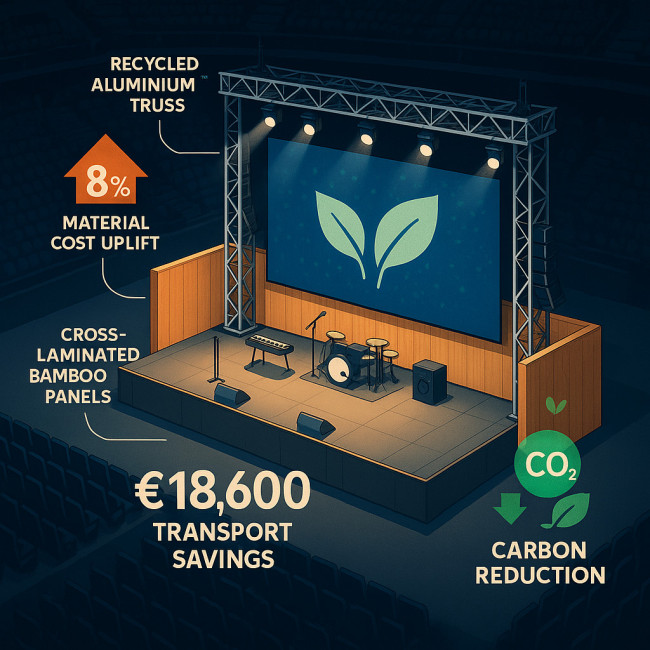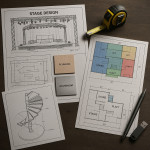Sustainable stage scenography 2025: eco-smart materials that impress producers
Looking to cut carbon, dazzle audiences, and keep budgets under control? This guide breaks down the latest eco-smart materials and workflows that make sustainable stage scenography a producer's dream in 2025. You'll leave with actionable specs, cost ranges, and sourcing tips to green-light your next show fast.
Why sustainable stage scenography is now a producer priority
Ticket buyers, sponsors, and streaming platforms increasingly demand transparent sustainability metrics. A 2024 Live Events Sustainability Index showed 67 % of producers lost at least one bid because their set design failed to meet eco criteria. Sustainable stage scenography answers three core business pressures:
- Reduced operating costs thanks to lighter freight and energy-efficient lighting.
- Risk mitigation as upcoming regulations tighten landfill and embodied-carbon limits.
- Marketing edge—an eco-label on tour posters boosts sponsor conversions by up to 12 %.
Material breakthroughs every scenographer should know
1. Recycled aluminium scenic frames
Aluminium already dominates touring truss systems, yet primary smelting emits 13.5 kg CO₂e/kg. Switching to certified recycled stock slashes that to 1.9 kg CO₂e/kg while retaining strength. Modular bolted joints mean fast strikes and fewer truckloads, earning smiles from logistics teams and the planet alike.
2. Cross-laminated bamboo panels
Bamboo sequesters carbon during growth and reaches harvest maturity in four years. CLB panels rival plywood for load bearing but weigh 20 % less, cutting rigging motor sizes. Pre-finished surfaces eliminate toxic paints, streamlining compliance with 2025 stage safety rules.
3. Bio-based foams & fabrics
Corn-starch PLA foams and mycelium cores replace petroleum EPS in props. Pair them with hemp or Tencel stage drapes to create compostable set elements. After closing night, materials can feed industrial composters rather than landfills.
4. Digital scenography as material avoidance
LED volumes, XR backdrops, and projection-mapped gauzes reduce physical build footprints by up to 60 %. Integrate these with augmented-reality workflows to pre-visualise blocking, minimising revision waste.
Source : Circular Economy Earth Database
Quick-glance comparison table
| Material | Typical use | CO₂e reduction vs 2020 baseline | Cost delta | End-of-life path |
|---|---|---|---|---|
| Recycled aluminium | Truss & frames | -85 % | +8 % | Infinite recycling |
| CL bamboo | Floor & flats | -62 % | +5 % | Re-use panels |
| Mycelium foam | Props | -70 % | +12 % | Compost |
| LED volume | Backdrops | -60 % | Capex intensive | Repurpose screens |
Budget & ROI: talking numbers with producers

Eco options still face a “green premium,” yet total project costs often drop once freight, strike labour, and waste fees shrink. Use the budget decoded guide to model scenarios. For a 12-city arena tour, switching to recycled aluminium and bamboo panels trimmed transport weight by 4.2 t, saving €18 600 in diesel and tolls—more than covering the 8 % material uplift.
Workflow shifts that drive sustainable stage scenography success
Early digital twin modelling
Build a cloud-based replica of your set to test rigging stresses and cue sequences. See how digital twins slash revisions and keep material orders tight.
Supplier vetting & certifications
- Look for ISO 14001 or Cradle-to-Cradle labels.
- Request batch-specific Environmental Product Declarations (EPDs) from mills.
- Audit recycling take-back programmes in contracts.
End-of-life logistics
Plan disposal before the first plank ships. Many recyclers offer show-day collection, reducing haul-back costs. Producers appreciate seeing the closed-loop plan in the technical rider.
Case-study sparkle: winning over stakeholders
The immersive theatre hit “Neon Forest” deployed 70 % reclaimed scaff tubes and projected foliage instead of printed scrims. The production team sourced talent via an award-winning stage scenographer profile on Artfolio and met its carbon-neutral pledge three months early.
FAQ
- Does sustainable stage scenography always cost more?
- Material unit prices can be higher, but savings on transport, labour, and disposal frequently offset the premium.
- How do I verify a supplier's green claims?
- Ask for third-party EPDs, chain-of-custody certificates, and evidence of closed-loop recycling programmes.
- Can I mix digital and physical set elements?
- Absolutely. Hybrid designs often yield the best storytelling and environmental outcomes; just plan projector sightlines early.
- What if my venue lacks composting facilities?
- Contract a mobile industrial composter or ship lightweight biomaterials to the nearest certified facility.
Test your knowledge
Take the next step
Ready to put sustainable stage scenography at the heart of your next production? Bookmark our eco-smart material roadmap and reach out to scenographers who already master these practices. By combining lighter materials, smart design tools, and transparent metrics, you'll wow audiences and producers alike—while safeguarding the planet.











